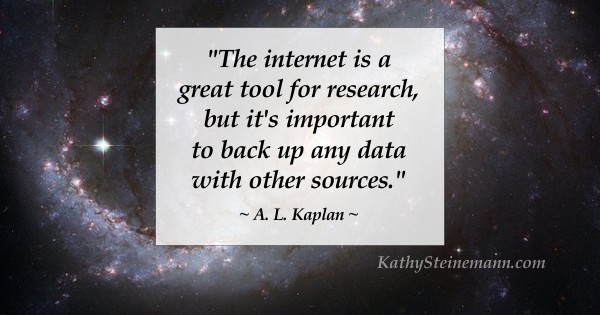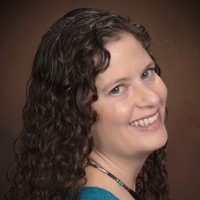
“The business end of writing is no fun. I wish I had someone to do all that stuff for me so I could focus on creating. … If I could go back in time, I’d tell myself to not be afraid to write ideas down even if things are misspelled. At least things would be recorded for later editing. Too many story ideas have gotten lost because of that.” ~ A. L. Kaplan

Here’s an oldie but goodie — an interview with A. L. Kaplan, one of the talented authors who collaborated with me on Suppose: Drabbles, Flash Fiction, and Short Stories. Her award-winning stories “A Chance Meeting—or Not”, “Blood Money”, “Pup ’O Lantern”, and “Regrets” appear in the anthology.
How long have you been writing?
I’ve created stories for as long as I can remember, but it wasn’t until late high school that I tried to write any of them down. My “artistic” handwriting and “creative” spelling used to get in the way. Now I can get my ideas out quickly without agonizing about technicalities. That’s what editing and rewrites are for. I remember the day a college friend introduced me to the school’s computer lab and spellcheck programs. I was so happy I almost cried. It was the first time I truly felt confident about my writing.
What was your favorite book as a child?
There were many books I loved to read growing up. Most of them were about animals like Call of the Wild, My Friend Flicka, and books by Albert Payson Terhune and James Herriot. Laura Ingalls Wilder was another author I enjoyed. All of these helped shape who I am. If I had to pick my favorite and most influential, it would be Julie of the Wolves by Jean Craighead George. My Side of the Mountain and Island of the Blue Dolphins are tied for second place. Incidentally, my favorite musicals growing up were Annie and Oliver. It seems I have a thing for kids struggling to survive on their own.
As an adult?
Definitely Lord of the Rings by J. R. R. Tolkien. It opened the whole world of fantasy to me. My brother gave me a copy when I was thirteen but the prologue put me off a bit. Once I actually read it, I couldn’t put it down. As soon as I finished it, I turned around and reread it two more times. I think the movie adaptations were awesome. Unfortunately, The Hobbit movies were a huge disappointment. Don’t get me started on what was wrong with them. It would take too long.
What are your favorite genres, both for reading and writing?
I read mostly fantasy with a smattering of historical fiction, but tend to write science fiction. My sci-fi isn’t hard core techno space stuff. It’s more soft science fiction with some fantasy elements. I’m particularly fond of dystopian stories. Of course my short works and poems run the genre gambit.
Can you tell us something about your activities in authors’ groups?
I’m a member of the Maryland Writers’ Association and am president of the Howard County chapter. I’m also in a critique group that meets monthly.
What’s the best thing about being an author?
I think the best thing about being an author is taking a little idea or thought and turning it into a whole new thing. My college major is sculpture. That means I hold a masters degree in un-employability. The literary arts are a natural branch of fine arts. It was only a matter of time before the images in my mind grew into words.
What’s the worst thing about being an author?
The business end of writing is no fun. I wish I had someone to do all that stuff for me so I could focus on creating.
Where do you get your inspiration and ideas?
Many of my ideas come from dreams, although one of my recent short stories was inspired by a song. The stories in Suppose were all born from writing prompts on Indies Unlimited. I keep a pad of paper by my bed for nighttime inspiration and one in my car. I don’t know what it is about driving, but it makes ideas pop.
Do you develop detailed plots before writing, or are you a pantser?
I’m somewhere between a pantser and a plotter. Dream-based story ideas sort of grow on their own. I have a general idea where I want the story to go, but plans sometimes change. For novel length stories I usually have a beginning, an end, and a few scenes in the middle. The challenge is connecting them all together.
How do you research the details?
The internet is a great tool for research, but it’s important to back up any data with other sources. Good old-fashioned books are great. Sometimes I go to the library and hang out in a section.
What do you do when you’re not writing?
When I’m not writing, I manage props for a local theatre. I’ve also dabbled in costumes but steer clear of the stage. My latest venture is agility dog training. I adopted a very energetic and lovable dog last year. We’re both having a great time.
What advice would you give to your younger self?
If I could go back in time, I’d tell myself to not be afraid to write ideas down even if things are misspelled. At least things would be recorded for later editing. Too many story ideas have gotten lost because of that.
What was the last book you couldn’t put down?
I just finished Shadow Study by Maria V. Snyder. Loved it.
Where can we find you on the internet?
My blog address is alkaplan.wordpress.com.
My Twitter name is alkaplanauthor.
The Writer’s Lexicon series
and additional resources on my Facebook page.
Discover more from KathySteinemann.com: Free Resources for Writers
Subscribe to get the latest posts sent to your email.
